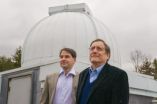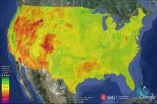In this release:
Regional models expect drier, stormier western United States Declining sea ice to lead to cloudier Arctic Improving plume forecasts using Fukushima data How did the equatorial ridge on Saturn's moon Iapetus form? Thermokarst lakes increased atmospheric methane levels North American rivers are a sizable source of atmospheric carbon Reforestation efforts reshape Hawaii's soil hydrology
Anyone may read the scientific abstract for any already-published paper by
clicking on the link provided at the end of each Highlight. You can also read the
abstract by going to http://www.agu.org/pubs/search_options.shtml and inserting
into the search engine the full doi (digital object identifier), e.g.
10.1029/2011GL050762. The doi is found at the end of each Highlight below.
Journalists and public information officers (PIOs) at educational or scientific
institutions who are registered with AGU also may download papers cited in this
release by clicking on the links below. Instructions for members of the news
media, PIOs, and the public for downloading or ordering the full text of any
research paper summarized below are available at
http://www.agu.org/news/press/papers.shtml.
1. Regional models expect drier, stormier western United States
As American southwestern states struggle against ongoing drought, and the
Northwest braces for a projected shift from a snow- to a rain-dominated
hydrological system, climate researchers strive to provide precipitation
projections that are fine grained enough to be of value to municipal water
managers. Estimates derived from large general circulation models show that in a
warming world, water availability in the western United States will be
increasingly dictated by extreme events. However, such large models tend to lack
necessary detail for the small-scale interactions and topographic influences that
dominate daily changes in local precipitation. To convert the broad predictions of
global models into practical predictions, Dominguez et al. used an ensemble of
regional models, set to fit within the projections of general circulation models, to
estimate future winter average and extreme precipitation for the western United
States.
The authors find that for the years 2038-2070, winter average precipitation in the
southwestern states would be 7.5 percent below 1979-1999 levels. They also find,
for the entire areal-averaged western United States, a 12.6 percent increase in the
magnitude of 20-year-return-period winter storms and a 14.4 percent increase for
50-year winter storms. In some regions, like southern California and northwestern
Arizona, this increase in strength of 50-year storms was pushed as high as 50
percent. Though the temporal and spatial granularity of the regional climate
models is much improved over that of general circulation models, workable and
useful measurements for hydrological engineering and water management design
will need ever-better estimates of future rainfall patterns.
Source:
Geophysical Research Letters, doi:10.1029/2011GL050762, 2012
http://dx.doi.org/10.1029/2011GL050762
Title:
Changes in winter precipitation extremes for the western United States under a
warmer climate as simulated by regional climate models
Authors:
F. Dominguez, E. Rivera, and C. L. Castro: Department of Atmospheric Sciences,
University of Arizona, Tucson, Arizona, USA;
D. P. Lettenmaier: Department of Civil and Environmental Engineering,
University of Washington, Seattle, Washington, USA.
2. Declining sea ice to lead to cloudier Arctic
Arctic sea ice has been declining over the past several decades as global climate
has warmed. In fact, sea ice has declined more quickly than many models
predicted, indicating that climate models may not be correctly representing some
processes controlling sea ice.
One source of uncertainty in models is feedback from cloud cover. Sea ice can
affect cloud cover, as melting sea ice and increased evaporation from the ocean
surface can lead to more cloud formation. In the Arctic, clouds have an overall
warming effect on the surface, so greater cloudiness in this region could lead to
even more sea-ice melt.
Liu et al. analyzed satellite observations of cloud cover and sea ice from 2000 to
2010 to evaluate feedbacks between sea ice and cloud cover. They find that a 1
percent decrease in sea ice concentration leads to a 0.36-0.47 percent increase in
cloud cover, and that 22-34 percent of variance in cloud cover can be explained
by changes in sea ice. So as sea ice declines, the researchers predict that the
Arctic will become cloudier.
Source:
Geophysical Research Letters, doi:10.1029/2012GL051251, 2012
http://dx.doi.org/10.1029/2012GL051251
Title:
A cloudier Arctic expected with diminishing sea ice
Authors:
Yinghui Liu: Cooperative Institute for Meteorological Satellite Studies,
University of Wisconsin-Madison, Madison, Wisconsin, USA;
Jeffrey R. Key: Center for Satellite Applications and Research, NESDIS, NOAA,
Madison, Wisconsin, USA;
Zhengyu Liu: Department of Atmospheric and Oceanic Sciences, University of
Wisconsin-Madison, Madison, Wisconsin, USA, and Center for Climate
Research, University of Wisconsin-Madison, Madison, Wisconsin, USA;
Xuanji Wang: Cooperative Institute for Meteorological Satellite Studies,
University of Wisconsin-Madison, Madison, Wisconsin, USA;
Stephen J. Vavrus: Center for Climate Research, University of Wisconsin-
Madison, Madison, Wisconsin, USA.
3. Improving plume forecasts using Fukushima data
Forecasting how plumes of particles, such as radioactive particles from a nuclear
disaster, will be transported and dispersed in the atmosphere is an important but
computationally challenging task. During the Fukushima nuclear disaster,
operational plume forecasts were produced each day, but as the emissions
continued, previous emissions were not included in the simulations used for
forecasts because it became impractical to rerun the simulations each day from the
beginning of the accident.
Draxler and Rolph examined whether it is possible to improve plume simulation
speed and flexibility as conditions and input data change. The authors used a
method known as a transfer coefficient matrix approach that allowed them to
simulate many radionuclides using only a few generic species for the
computation. Their simulations work faster by dividing the computation into
separate independent segments in such a way that the most computationally time-
consuming pieces of the calculation need to be done only once. This makes it
possible to provide real-time operational plume forecasts by continuously
updating the previous simulations as new data became available. They test their
method using data from the Fukushima incident to show that it performs well.
Source:
Journal of Geophysical Research-Atmospheres, doi:10.1029/2011JD017205,
2012 http://dx.doi.org/10.1029/2011JD017205
Title:
Evaluation of the Transfer Coefficient Matrix (TCM) approach to model the
atmospheric radionuclide air concentrations from Fukushima
Authors:
Roland R. Draxler and Glenn D. Rolph: NOAA Air Resources Laboratory,
Silver Spring, Maryland, USA.
4. How did the equatorial ridge on Saturn's moon Iapetus form?
Saturn's moon Iapetus is one of the most unusual moons in our solar system.
Perhaps the most bizarre feature of Iapetus is its equatorial ridge, a 20-km (12.4-
mi) high, 200-km (124-mi) wide mountain range that runs exactly along the
equator, circling more than 75 percent of the moon. No other body in the solar
system exhibits such a feature, and as Dombard et al. show, previous models have
been unable to adequately explain how the ridge formed.
The authors now propose that the ridge formed from an ancient giant impact that
produced a subsatellite around Iapetus. Tidal interactions with Iapetus ultimately
led to orbital decay, eventually bringing the subsatellite close enough that the
same forces tore it apart, forming a debris ring around Iapetus. Material from this
debris ring then rained down on Iapetus, creating the mountain ring along the
equator.
Source:
Journal of Geophysical Research-Planets, doi:10.1029/2011JE004010, 2012
http://dx.doi.org/10.1029/2011JE004010
Title:
Delayed formation of the equatorial ridge on Iapetus from a subsatellite created in
a giant impact
Authors:
Andrew J. Dombard: Department of Earth and Environmental Sciences,
University of Illinois at Chicago, Chicago, Illinois, USA;
Andrew F. Cheng: Johns Hopkins University Applied Physics Laboratory,
Laurel, Maryland, USA;
William B. McKinnon: Department of Earth and Planetary Sciences and
McDonnell Center for Space Sciences, Washington University, St. Louis,
Missouri, USA;
Jonathan P. Kay: Department of Earth and Environmental Sciences, University of
Illinois at Chicago, Chicago, Illinois, USA.
5. Thermokarst lakes increased atmospheric methane levels
Greenland ice cores indicate that during the last deglaciation, approximately
10,000 years ago, increases in temperature occurred at the same times as increases
in atmospheric methane, a potent greenhouse gas. The source of the increase in
atmospheric methane is still debated, but it has been suggested that thermokarst
lakes, which form from thawing permafrost, contributed to the increased
atmospheric methane. Brosius et al. reconcile bottom-up estimates of emission of
methane from thermokarst lakes in various Arctic regions with isotope constraints
from ice core records. They did this by establishing pathways of regionally
varying hydrogen isotopes found in permafrost ground ice to methane produced in
thermokarst lakes. The researchers show that thermokarst lakes were indeed an
important source of atmospheric methane during the deglacial period.
Source:
Journal of Geophysical Research-Biogeosciences, doi:10.1029/2011JG001810,
2012 http://dx.doi.org/10.1029/2011JG001810
Title:
Using the deuterium isotope composition of permafrost meltwater to constrain
thermokarst lake contributions to atmospheric CH4 during the last deglaciation
Authors:
L. S. Brosius: Department of Biology and Wildlife, University of Alaska
Fairbanks, Fairbanks, Alaska, USA and Institute of Northern Engineering,
University of Alaska Fairbanks, Fairbanks, Alaska, USA;
K. M. Walter Anthony: Institute of Northern Engineering, University of Alaska
Fairbanks, Fairbanks, Alaska, USA;
G. Grosse: Geophysical Institute, University of Alaska Fairbanks,
Fairbanks, Alaska, USA;
J. P. Chanton: Department of Earth, Ocean and Atmospheric Science, Florida
State University, Tallahassee, Florida, USA;
L. M. Farquharson: Institute of Northern Engineering, University of Alaska
Fairbanks, Fairbanks, Alaska, USA and Department of Geology, University of
Alaska Fairbanks, Fairbanks, Alaska, USA;
P. P. Overduin and H. Meyer: Alfred Wegener Institute for Polar and Marine
Research, Potsdam, Germany.
6. North American rivers are a sizable source of atmospheric carbon
To fulfill the need for an ever more accurate and complete understanding of the
flow of carbon through the Earth system, a flurry of research has taken place in
the past decade on previously overlooked aspects of the carbon cycle. Researchers
have investigated the roles of rivers, lakes, and streams in transporting carbon,
often with mixed, or only broadly constrained, results. Further, many
investigations have traditionally focused on a small number of sites. Though such
focused measurements are important for pinning down spatial and temporal
changes in the local exchange of carbon, they make expanding the results to
broader regions difficult.
To address both sets of issues, Lauerwald et al. used a carbon flux model, trained
by a broad set of high-resolution chemical and physical measurements drawn
from rivers across North America, to determine the physical watershed properties
that are the strongest predictors of dissolved organic carbon fluxes and to provide
a rough estimate of continental-scale carbon exchange. They find that runoff
volumes, tree cover, watershed slope, and the areal extent of wetlands are the
strongest independent determinants of watershed dissolved organic carbon fluxes.
The authors find that from North American rivers that lay south of the 60th
parallel, 5.9 megatons of carbon are transferred to the atmosphere each year.
The authors acknowledge the broad diversity of North American watersheds, and
they suggest that the model likely underestimates carbon fluxes in cold regions
and overestimates the flux for warmer regions. The model also looks only at the
natural transport of carbon through the ecosystem and does not represent
anthropogenic point sources of carbon. As such, the authors suggest that their
estimate likely represents a lower limit on the contributions of North American
rivers to atmospheric carbon dioxide concentrations.
Source:
Journal of Geophysical Research-Biogeosciences, doi:10.1029/2011JG001820,
2012 http://dx.doi.org/10.1029/2011JG001820
Title:
Assessing the nonconservative fluvial fluxes of dissolved organic carbon in North
America
Authors:
Ronny Lauerwald, Jens Hartmann, and Nils Moosdorf: Institute for
Biogeochemistry and Marine Chemistry, KlimaCampus, University of Hamburg,
Hamburg, Germany;
Wolfgang Ludwig: Centre de Formation et de Recherche sur l'Environnement
Marin, UMR 5110, Université de Perpignan Via Domitia, Perpignan, France.
7. Reforestation efforts reshape Hawaii's soil hydrology
Starting with the arrival of Polynesian settlers in the fourth century, and peaking
in the mid-1800s, the destructive forces of wildfires and pests and the grazing of
feral pigs, goats, and cattle reduced the native forests of Maui, Hawaii, to just a
tenth of their original extent. Maui's native vegetation was replaced largely by
imported or invasive species. Over time, the invasive grasses that took root
reshaped the hydrological properties of the soil, reducing the viability of native
plant species that had evolved to thrive under Hawaii's previous hydrological
dynamics. Maui's ecosystem had been changed for so long that scientists were
uncertain whether the region could actually again support the native flora.
Starting in 1997, a 10-acre area was fenced off to prevent access by cattle,
invasive grasses were killed with herbicide, and fast growing native shrubs were
planted in an attempt to restore Maui's native forest ecosystem. Having now been
expanded to 50 acres, the Auwahi reforestation project was the site of an
investigation by Perkins et al., who sought to find out whether the reintroduction
of native species could reverse the changes in the soil's hydrologic properties
brought about by erosion, invasive grasses, and other forces. The authors
measured soil water infiltration rates, soil hydrophobicity, and the density and
prevalence of preferential soil flow paths at 31 sites in the reforested ecosystem
and 24 locations in a neighboring grassland. They find that in the reforested area,
the soil's hydrologic properties had changed to enable water to penetrate to deeper
depths and to do so more quickly-conditions amenable to deeper-rooted trees
and native species. The authors' findings suggest that given concerted effort, even
long-standing and widespread ecosystem changes can be overturned by
conservation efforts.
Source:
Geophysical Research Letters, doi:10.1029/2012GL051120, 2012
http://dx.doi.org/10.1029/2012GL051120
Title:
Effects of native forest restoration on soil hydraulic properties, Auwahi, Maui,
Hawaiian Islands
Authors:
K. S. Perkins and J. R. Nimmo: U.S. Geological Survey, Menlo Park, California,
USA;
A. C. Medeiros: Haleakala National Park Field Station, Pacific Island Ecosystems
Research Center, U.S. Geological Survey, Makawao, Hawaii, USA.
INFORMATION:
END



